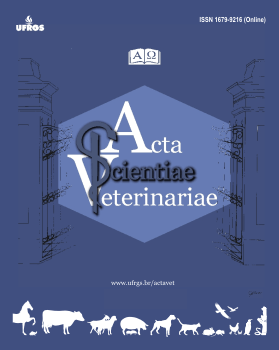Correction of Flexural Deformity of the Metacarpophalangeal Joint in a Calf
DOI:
https://doi.org/10.22456/1679-9216.118033Abstract
Background: The congenital flexural deformity is common in cattle, often affecting the metacarpophalangeal joint of the thoracic limbs. The deformity may be mild, moderate, or severe, and the therapy depends on the limb's degree of flexion and the affected joint. In severe deformities, tenotomy of the flexor tendons and desmotomy of the suspensor ligament is recommended. However, this surgical technique may not be sufficient to promote limb extension, and other interventions may be necessary. Thus, the purpose of this report is to describe a technique to correct severe flexural deformities of the metacarpophalangeal joint in calves.
Case: A three-month-old, female, Dutch-bred calf weighing 46 kg was referred for treatment of congenital flexural deformity. On attendance, the patient presented severe deformity in the right thoracic limb and mild in the left thoracic limb both at the height of the metacarpophalangeal joints. During palpation it was possible to notice that the flexor tendons were contracted in both limbs. Radiographic exams were performed to rule out the presence of other diseases, confirming the diagnosis of flexural deformity. The patient was referred to surgery to correct the anatomical anomaly. The animal was submitted to general anesthesia and placed in right lateral decubitus. In the left thoracic limb, an incision was made in the medial region of the metacarpal bone, the tissues were divulsioned until the superficial digital and deep digital flexor tendons were exposed; these structures were sectioned with a scalpel, and the limb was extended, returning to the standard anatomical position. In the right thoracic limb, the same procedure was performed, but during the limb extension test, we observed that the limb remained flexed, we then followed with a second incision and section of the deep digital flexor tendon in the palmar region at the middle phalanx of the lateral and medial digits, with this procedure, the limb extended further. Nevertheless, the procedure was not enough to solve the problem in the right thoracic limb, and the patient needed a second surgical intervention, in which we performed again tenotomy of the flexor tendons and desmotomy of the digital annular, crossed sesamoid, and interdigital phalangiosamoid ligaments, associated to the capsule opening of the capsule from the affected right metacarpophalangeal joint. After this surgery, the patient recovered to the normal anatomical position of the right thoracic limb. The procedures were efficient in achieving the normality of both affected limbs, and the patient recovered without postoperative complications.
Discussion: In severe flexural deformities of the metacarpophalangeal joint in bovines, the fetlock's flexor tendons and suspensory ligament are implicated in the limb contracture. For these cases the chosen treatment is surgery with sequential sectioning of the flexor tendons and the suspensory ligament until the extension of the flexed limb occurs. Although there are reports that confirm the efficacy of this technique, there are cases in which other anatomic structures are involved in the limb contracture. In addition, the desmotomy and tenotomy techniques are not enough to achieve the normality of the affected joint, with the limb remaining flexed, leading to euthanasia of the patient in some cases. In cattle, few reports demonstrate possible techniques for severe contractures of the metacarpophalangeal joint, requiring further studies and new techniques to achieve recovery of these patients.
Keywords: bovine, congenital, anatomical anomaly, contracture, tendon, fetlock.
Descritores: bovinos, congênita, anomalia anatômica, contratura, tendão, boleto.
Título: Correção de deformidade flexural da articulação metacarpofalangeana em uma bezerra
Downloads
References
Abdelhakiem M.A. & Elrashidy M.H. 2017. A Retrospective Study of the Congenital Anomalies of the Axial and Appendicular Skeleton in Cow Calves. Assiut Veterinary Medical Journal. 63: 88-99.
Anderson D.E., Desrochers A. & Jean G.S. 2008. Management of Tendon Disorders in Cattle. Veterinary Clinics of North America: Food Animal Practice. 24(3):551-566.
Corrêa R.R. & Zoppa A.L.D.V. 2007. Deformidades Flexurais em Eqüinos: Revisão Bibliográfica. Ensaios e Ciência. 5(5):37-43.
Fernandes M.E.D.S.L., Carvalho L.D.A., Chenard M.G., Pitombo C.A., Santos O.J.D., Caldas S.A., Nogueira V.A. & Helayel M.A. 2020. Manejo da Deformidade Flexural Congênita em Bezerro - Aspectos Cirúrgicos e Patológicos-Relato de Caso. Acta Scientiae Veterinariae. 48(1):1-5.
Gangwar A.K., Devi K.S., Singh A.K., Katiyar N., Patel G. & Srivastava S. 2014. Congenital Anomalies and their Surgical Correction in Ruminants. Advances in Animal and Veterinary Sciences. 2(7): 369-376.
Leipold H.W., Hiraga T. & Dennis S.M. 1993. Congenital Defects of the Bovine Musculoskeletal System and Joints. Veterinary Clinics of North America: Food Animal Practice. 9(1): 93-104.
Palsania S.K., Palecha S., Singh S., Pooniya R., Saini R., Kumar S. & Singh N. 2019. A Clinical Study on the Surgico-Therapeutic Management of Diverse Congenital Surgical Affections in Ruminants. Veterinary Practitioner. 20(1): 44-50.
Sato A., Kato T. & Tajima M. 2020. Flexor Tendon Transection and Post-Surgical External Fixation in Calves Affected by Severe Metacarpophalangeal Flexural Deformity. Journal of Veterinary Medical Science. 82(10): 1480.
Steiner A., Anderson D.E. & Desrochers A. 2014. Diseases of the Tendons and
Tendon Sheaths. Veterinary Clinics: Food Animal Practice. 30: 157-175.
Published
How to Cite
Issue
Section
License
This journal provides open access to all of its content on the principle that making research freely available to the public supports a greater global exchange of knowledge. Such access is associated with increased readership and increased citation of an author's work. For more information on this approach, see the Public Knowledge Project and Directory of Open Access Journals.
We define open access journals as journals that use a funding model that does not charge readers or their institutions for access. From the BOAI definition of "open access" we take the right of users to "read, download, copy, distribute, print, search, or link to the full texts of these articles" as mandatory for a journal to be included in the directory.
La Red y Portal Iberoamericano de Revistas Científicas de Veterinaria de Libre Acceso reúne a las principales publicaciones científicas editadas en España, Portugal, Latino América y otros países del ámbito latino





